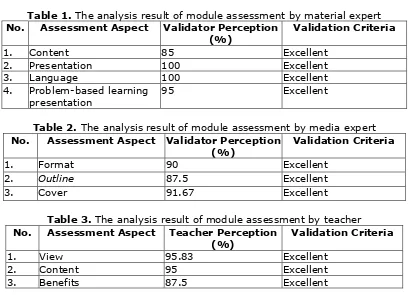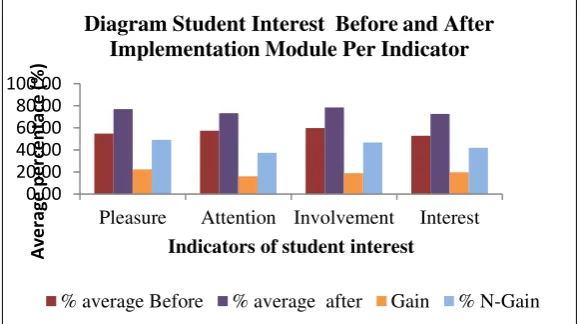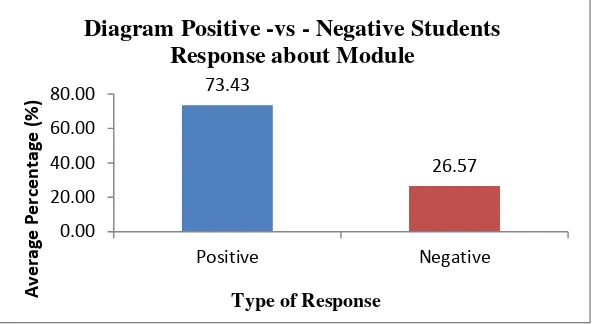786
Implementation of Problem Based Learning
Module to Improve Students’ Interest in
Physics Learning
1*
A. Halim,
2Adlim,
3Izkar Hadiya and
4Eviza Nurfadilla
1
Department of Physic Education, Teacher Training and Education Faculty, Syiah Kuala University, Indonesia;
2
Department of Chemistry Education, Teacher Training and Education Faculty, Syiah Kuala University, Indonesia;
3
Physics Teacher of High School, Banda Aceh, Indonesia;
4
Student of Physics Education Department, Teacher Training and Education Faculty, Syiah Kuala University, Indonesia;
*
Corresponding author: [email protected]
Abstract
This study aims to determine the effectiveness of the module that have been developed to improve the student's interest in learning, the advantages and disadvantages of the module, and the implementation of module for learning. The method of this research is Research and Development. The research population is science students class X in Senior High School 1 Peusangan, and sample group which determined by random technique is science student class X-1. The collected data are data of module assessment by teaching materials expert; media expert; and the teacher, data of student interest before and after learning with module, student’s response about the module, and teacher interview. The research instruments are the module assessment sheet for teaching materials expert; media expert; and the teacher, the student’s interest in learning questionnaire, questionnaire for student response, and the interview guidelines for teacher. The module effectiveness is determined with statistical test t correlated to average gain student interest before and after learning with module. The results showed significance difference between students' interest before and after is 41.30 % and students’ positive response about module is 73.43%. Analysis of the strengths and weaknesses of the module is obtained that module can create active learning for students with a scientific approach, but the participation of the teacher and completely facilities determine the learning process.
Keywords: module, problem-based learning, student interest.
Introduction
A. Halim, Adlim, Izkar Hadiya and Eviza Nurfadilla
787 teaching materials in accordance with the curriculum standards in 2013 (Kementrian Pendidikan dan Kebudayaan, 2013).
The module is one of the teaching materials related with the Curriculum 2013, because the modules according to the Ministry of National Education (2008) has a number of advantages over text books that the student can study independently and guide the student to solve difficulties in learning. Module provides guidance on learning activities that are well planned, self-contained and completed with clear results.
According to field preliminary observation before this study about the implementation of Curriculum 2013 in region, not all schools have the Curriculum 2013 standard, so they still use the KTSP text books. The KTSP text books according to Srijaya (2012) only contains a summary of the material, sample questions and exercises, so it will be a little difficult to implement learning in accordance with the Curriculum 2013. So modules are required in learning, one of them in physics subject, because physics is an important subject which helps students to understand natural phenomena (Hewitt & Romer et.al., 2011), so that the learning of physics should be emphasized on student learning experience directly.
Module development is done to the material temperature and heat because the material is a little difficult to learn because it is abstract that can cause a variety of different ideas for students (Baser, 2006). Moreover, this is a key concept for students to understand other scientific concepts (Sozbilir, 2003).
Literature Review
Van et al. (2003) have designed a module about heat with problem-based approach, and found that the students' interest and motivation can be enhanced with the module. Problem-based learning modules can increase the interest and motivation of students because students are faced with the problem of unstructured contextual and students are asked to find solutions to these problems (Rhem, 1998). In addition, students can develop skills in solving problems effectively such as the ability to apply meta-cognitive strategies, proper reasoning, and develop self-directed learning and skills for a long time, and became a collaborator in work teams (Barrow & Kelson in Hmelo Silver, 2004). Problem-based learning also allows students to learn actively and students more responsible for their learning outcomes (Hmelo & Ferrari, 1997). A number of surveys have shown an association between problem-based learning by improving learning and student activities as expressed Chakir & Tekkaya in Akinoglo & Tandogan (2007), Alper (2008), Ihsen et al. (2011), Pirrami & Perez (2011), Mossoto (2008), and Pratiwi (2013). Problem-based learning has been adopted widely as a model of physics learning as expressed Hirca (2011).
Research Method
This study was held on April 24th until May 9th 2014 at Senior High School 1 Peusangan. The module was developed by the Research and Development method, the stages of module development are the analysis of the potential problems, gathering information, design the module, module design validation, design revisions, limited testing, revision of the initial module, wider testing, and revision of the final module. Module is validated by one lecturer of teaching material expert and one lecturer of media expert from the Faculty of Training and Education (FKIP) at Syiah Kuala University.
788 Data from the module assessment by the experts and teachers is calculated with percentages formula that compares the total score obtained by assessment sheet with the criterion score (maximum score). The student response data to the module is calculated with percentage formula that the proportion of students who chose each alternative answers divided by the number of students.
The effectiveness of the module in improving students’ learning interest is niormal
and homogeneous data, so it can be analyzed by t test that is comparing data before and after the treatment (Sugiyono, 2013). Normality test determine with the method Kosmolgorov Smirnov and homogeneity test with F test of Havley. The magnitude of the increase is determined by the gain index <g>, the criteria in consultation with the Criteria Table Gain from Meltzer (2002).
The information obtained from interviews with physics teachers, analyzed with interactive model of Miles and Huberman. The information is used as a support to explain the results of the quantitative analysis.
Results and Discussion
At the module development there are several revisions based on the input from teaching material and media expert, teachers, and students. The revisions are the cover becomes simpler, have an understanding test about the material, the purpose of learning based on Curriculum 2013, student assessment sheet based on indicators of learning achievement, the language used is simpler and easier to understand, and tutorial of student activities related to problem-based learning. Therefore the module becomes easy to understand and suitable to apply in Curriculum 2013. The module assessment result from the experts and teachers are presented in the following table.
Table 1. The analysis result of module assessment by material expert
No. Assessment Aspect Validator Perception (%)
Validation Criteria
1. Content 85 Excellent
2. Presentation 100 Excellent
3. Language 100 Excellent
4. Problem-based learning presentation
95 Excellent
Table 2. The analysis result of module assessment by media expert
No. Assessment Aspect Validator Perception (%)
Validation Criteria
1. Format 90 Excellent
2. Outline 87.5 Excellent
3. Cover 91.67 Excellent
Table 3. The analysis result of module assessment by teacher
No. Assessment Aspect Teacher Perception (%)
Validation Criteria
1. View 95.83 Excellent
2. Content 95 Excellent
3. Benefits 87.5 Excellent
A. Halim, Adlim, Izkar Hadiya and Eviza Nurfadilla
Diagram Student Interest Before and After
Implementation Module Per Indicator
% average Before % average after Gain % N-Gain
The result of the module effectiveness to improve students’ interest in learning is shown in Figure 1. Figure 1 shows the increase in student interest before and after learning modules. Student interest on average is increased by 41.30 %. Average increase student interest per indicator is shown in Figure 2.
Figure 1. Average student interest before and after learning with module, difference (Gain), percentage (%) N – Gain.
Figure 2 shows an average increase of students’ interest for each indicator, the increase is almost same for all indicators. The largest increase was shown on the pleasure indicator to physics lesson, and the smallest on students’ attention indicators to the physics lesson. Accordingly, this problem-based learning module has been developed can increase the students’ interest in learning effectively. The
increased students’ interest in learning caused by one of advantages of module that
the student can do task which related with their ability (Utomo, 1991).
Figure 2. Increasing student interest average per indicators.
790 Learning with the module does not require the student to get the same result for every aspect of the assessment but each aspect of assessment integrated to complement each other so that students can develop in accordance with the talent. In addition, the module also makes students learn actively in collecting information from various sources in order to obtain optimal learning results. Students can feel the benefits of this learning, so that students are increasingly enjoys these learning.
Average response given to the module by students are classified by the positive responses and negative responses, which are analyzed from the students' answers to the question posed in the questionnaire assessment module, shown in Figure 3, which is 73.43 % of students give a positive response, and only 26.57 % of students which give a negative response.
Figure 3. Average students response to item questions in the module assessment sheet for students.
Proceedings of The 7th Annual International Conference (AIC) Syiah Kuala University and The 6th International Conference on Multidisciplinary Research (ICMR) in conjunction with the International Conference on Electrical Engineering and Informatics (ICELTICs) 2017, October 18-20, 2017, Banda Aceh, Indonesia
791 Enforceability of this learning activity, strongly influenced by the teacher's ability to perform its role, as stated Das et al. (2002) in their research, that learning is influenced by the attitude of the teacher module, which is the concern of teachers to the social background of students, and the teacher's ability to explain to the students about the rules used in the learning activities.
The result of observations to the learning activities with the module shows that the student can follow the learning activities required in the module. Learning with module is able to create an active learning for students with a scientific approach, because there is a protrusion dimensional observation, reasoning, discovery, validation, and explanation of a truth in the learning process as mentioned the Ministry of Education and Culture in Indonesia also called Kementerian dan Kebudayaan (2013).
Based on a series of learning activities of the student, it is clear that active learning with a scientific approach can be implemented with this module. Learning with this module is able to make the students utilize their logical, critical, creative and systematically thinking to solve the problems as mentioned Magsino (2014) in his research, that problem based learning is efficient to improve students' critical thinking skills. Students are able to analyze, synthesize and evaluate information presented in the problem. Higher order thinking skills of students can be enhanced through problem based learning, although did not show increased levels of thinking ability of students is significantly higher than conventional learning as mentioned in the research Masek & Yamin (2012), Ganiron (2014), Agnes (2002) and Temel (2014).
Conclusions
Problem based learning module developed can increase student interest significantly
about 41.30 % and students’ positive response about module is 73.43%. Modules
can create active learning with a scientific approach but the role of teachers and the availability of support facilities are still needed in order to study performing well. Completion of reading level, and display formats are also still needs to be done in order to more easily be used in the learning process. Comparative studies also should be conducted to compare the effectiveness of learning with this module and conventional learning in increasing student interest.
Acknowledgements
To all those who have assisted in the implementation of this research we thank you very much. To the head of Syiah Kuala University and research institute which has supported the fund for the implementation of this research we say many thanks.
References
Agnes, F.Y.T. (1998). The effect of problem based learning on student critical thinking disposition and approaches to learning: A study of the student nurse educators in Hongkong (master thesis). University of Wollogong, Hongkong. Akinoglo, O. & Ö. R. Tandogan. (2007). The effects of problem-based active learning
in science education on students’s academic achievement, attitude and concept learning. Eurasia Journal of Mathematics, Science and Techno-logy Education. 3(1), 71-81.
Alper, A. (2008). Attitudes toward problem based learning in a new Turkish Medicine. American Journal of Physics, 70, 12-13.
792 Departemen Pendidikan Nasional. (2008). Teknik penyusunan modul. Jakarta:
Direktorat Ditjen Depdiknas.
Djamarah, S.B. & A. Zain. (2002). Strategi belajar mengajar. Jakarta: Rineka Cipta. Ganiron, T.U. 2014. The impact of higher level thinking on student’s achievement
toward project management course. International Journal of u- and e-services Science and Technology, 7(3), 217-226
Hirca, N. (2011). Impact of problem-based learning to students and teachers. Asia-Pacific Forum on Science Learning and Teaching, 12(1)
Hmelo, D., & Ferrari, M. (1997). The problem-based learning tutorial: Cultivating higher order thinking skills. Journal for the Education of the Gifted, 20(4), 401-422.
Hmelo-Silver. (2004). Problem-based learning: What and how do students learn?
Educational Psychology Review, 16(3), 235-266.
Ihsen, S, W. Sneider, F. Wallhoff & J. Blume. (2011). Raising interest of pupils in engineering education through problem based learning. International Journal of Engineering Education, 7(4), 789 – 794.
Kementrian Pendidikan dan Kebudayaan. (2013). Bahan uji publik kurikulum 2013. Jakarta.
Magsino, R.M. (2014). Enhancing higher order thinking skills in a marine biology class through problem-based learning. Asia Pacific Journal of Multidisciplinary Research, 2(5), 1-6.
Masek, A. & S. Yamin. (2012). The impact of instructional methods on critical thinking a comparison of problem-based learning and conventional approach in engineering education. ISRN Education, 6.
Meltzer, D. E. (2002). The Relationship between mathematics preparation and conceptual learning gain in physics: A possible variable in diagnostic pre test score. Am Physics, 70(2), 1259-1267.
Mossoto, M. (2008). Problem-based learning: Student engagement, learning and contextualized problem-solving. Occasional Paper. Adelaide: NCVER. AVETRA 12th Annual Conference, Sydney. 16-17 April 2009.
Pratiwi, R. D. (2013). Peningkatan minat dan hasil belajar siswa pada materi pecahan melalui model problem based learning di kelas V Sekolah Dasar Negeri Randugunting 4 Kota Tegal (undergraduate dissertation). Universitas Negeri Semarang, Semarang.
Rhem, J. 1998. Problem based learning: An introduction. NTLF, 8(1).
Srijaya, S. P. (2012). Pengembangan modul fisika kontekstual untuk meningkatkan hasil belajar fisika siswa kelas X Semester 2 di SMK Negeri 3 Singaraja
(undergraduate dissertation). Program Pasca Sarjana, Universitas Pendidikan Ganesha, Bali.
Sugiyono. (2013). Metode penelitian pendidikan: Pendekatan kuantitatif, kualitatif, dan R & D. Bandung: Alfabeta.
Süzük, E, M. A. Çorlu & C. Gürel. (2011). Students’ perceptions of learning efficiency of introductory physics course. Eurasian J. Phys. Chem. Educ. Jan (Special Issue), 65-71
Temel, S. (2014). The effects of problem-based learning on pre-service teachers’ critical thinking dispo-sitions and perceptions of problem-solving ability. South African Journal of Education, 34(1), 1-20.
Utomo, T. (1991). Peningkatan dan pengembangan pendidikan. Jakarta: Gramedia Pustaka Utama.
Van Kampen, P, C. Banahan, M. Kelly, E. Mcloughlin & E. O’leary. (2003). Teaching a
single physics module through based learning in lecture-based curriculum.


